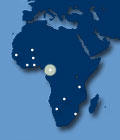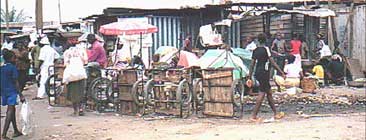|
||||||||||||
| Burkina Faso | Cameroon | Cote D’Ivoire | Ghana | Mali | Namibia | Senegal | Swaziland | Tanzania | Zambia | ||||||||||||
Information Source: Cameroon: Country Assessment Report. |
||||||||||||
|
||||||||||||
|
Context Summary Cameroon had an estimated population of 15 million in 2000 and annual population growth of 2.7 percent between 1995-2000. From 1978 to 1982, oil represented about 63 percent of total exports, and replaced cocoa and coffee as the leading export. According to the Human Development Index (HDI), Cameroon is ranked 134th out of 174 countries listed by UNDP in 2000. After independence, Cameroon experienced steady economic growth, social stability, and gradual national unification of the different provinces. Cameroon’s urban population is approximately 49 percent (7.4 million). There are two major cities: the main port and commercial center, Douala (population 1.4 million); and the administrative and political capital, Yaoundé (population 1.1 million). There is a high rate of urban growth in Yaoundé (6 percent) and Douala (4.9 percent), despite the fact that people are leaving for the main provincial towns because of the present economic situation. In 1988, urban poverty reached a level of 60 percent and about 70 percent of the population was living in unplanned settlements. The first main urban upgrading project in Cameroon and in sub-Sahara Africa was a multi-sectoral project started in 1984 in the Nylon zone in Douala. In this area, only 6 percent of the houses were built with permanent materials, an estimated 65 percent of residents are not connected to pipe-borne water, and 80 percent are not connected to sanitation facilities. Leakage and overflow from pit latrines and septic tanks has polluted the water table, which supplies water to wells and streams. This zone is vulnerable to flooding and occupied by a population living in precarious houses without formal property deeds. During the project design phase and the first years of its implementation, Cameroon was enjoying a period of considerable prosperity. In 1986 a serious recession set in. Growth stopped, oil prices dropped, exports of farm produce declined, urban unemployment increased very rapidly, public finance ran out, and domestic and external debt rose steeply. The government could no longer afford project commitments. The WB decided not to extend the implementation period of the project and it was closed in 1994, by which time 62 percent of the available funding had been consumed. Today projects are integrated into the decentralization framework and are focused on urban development through the implementation of micro-projects (infrastructure, services, facilities, and economic development). Projects no longer require land regulation and legalization as prerequisites. The FOURMI I project and its extension, FOURMI II, are examples of current urban upgrading efforts.
Lessons from Projects - Summary The Nylon Upgrading Project It should be noted that the project was not just complex but also a long-term undertaking, designed and initiated at a time of powerful economic growth, continued during the recession, and completed at a time of economic, social, and political crises. It demonstrated the difficulty involved in adopting a broad policy approach with ambitious policy and institutional objectives and a large scope of project activities. Achievements were mixed:
The project succeeded in:
The project experienced partial success in:
The project failed in:
Conclusions to be considered in subsequent projects:
Limits of micro-projects - FOURMI Projects
|
||||||||||||
|
|
||||||||||||
| For more information: Click on: Foreword and Overview 1. Problems and Context 2. Current Situation 3. Policy Context and Institutional Framework 4. Upgrading Projects and Programs 5. Case Study 6. Lessons Learned 7. Challenges and Proposed Next Steps Annex A: Country and City Profiles Annex B: Bibliography Annex C: Contact Information Annex D: Photographs Download for Printing: |
||||||||||||
| < Return to top > | ||||||||||||
|
||||||||||||


